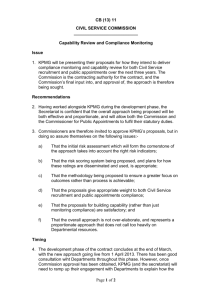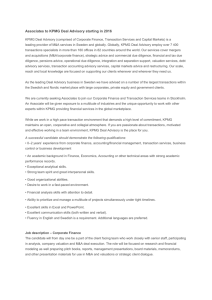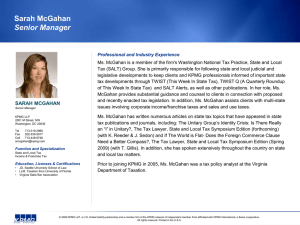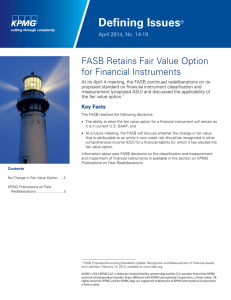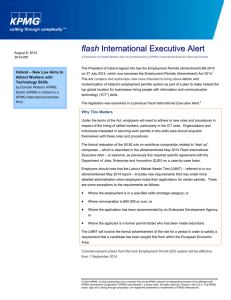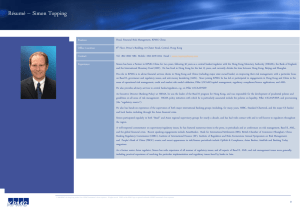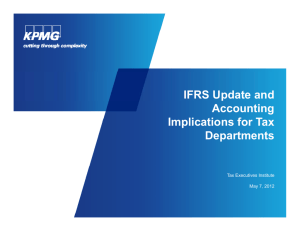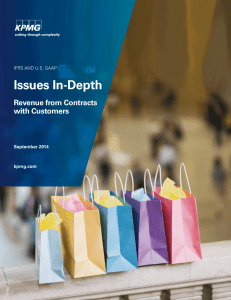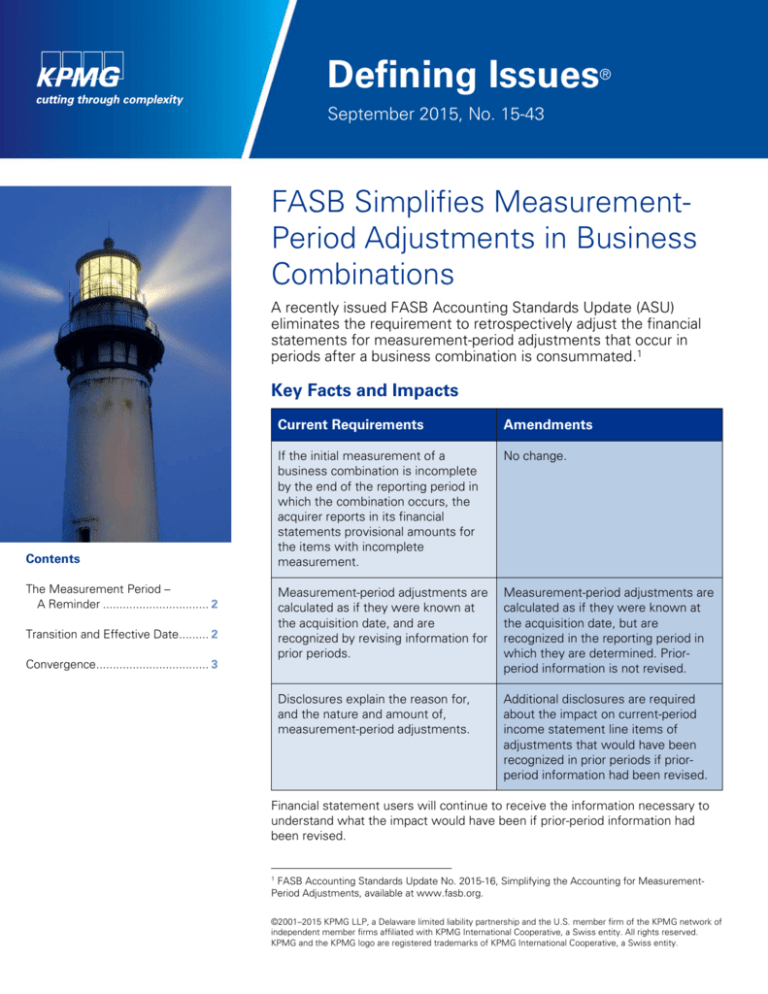
Defining Issues
®
September 2015, No. 15-43
FASB Simplifies MeasurementPeriod Adjustments in Business
Combinations
A recently issued FASB Accounting Standards Update (ASU)
eliminates the requirement to retrospectively adjust the financial
statements for measurement-period adjustments that occur in
periods after a business combination is consummated.1
Key Facts and Impacts
Contents
The Measurement Period –
A Reminder ................................ 2
Transition and Effective Date......... 2
Convergence.................................. 3
Current Requirements
Amendments
If the initial measurement of a
business combination is incomplete
by the end of the reporting period in
which the combination occurs, the
acquirer reports in its financial
statements provisional amounts for
the items with incomplete
measurement.
No change.
Measurement-period adjustments are
calculated as if they were known at
the acquisition date, and are
recognized by revising information for
prior periods.
Measurement-period adjustments are
calculated as if they were known at
the acquisition date, but are
recognized in the reporting period in
which they are determined. Priorperiod information is not revised.
Disclosures explain the reason for,
and the nature and amount of,
measurement-period adjustments.
Additional disclosures are required
about the impact on current-period
income statement line items of
adjustments that would have been
recognized in prior periods if priorperiod information had been revised.
Financial statement users will continue to receive the information necessary to
understand what the impact would have been if prior-period information had
been revised.
1
FASB Accounting Standards Update No. 2015-16, Simplifying the Accounting for MeasurementPeriod Adjustments, available at www.fasb.org.
©2001–2015 KPMG LLP, a Delaware limited liability partnership and the U.S. member firm of the KPMG network of
independent member firms affiliated with KPMG International Cooperative, a Swiss entity. All rights reserved.
KPMG and the KPMG logo are registered trademarks of KPMG International Cooperative, a Swiss entity.
Defining Issues® — September 2015, No. 15-43
The Measurement Period – A Reminder
New Disclosures but Filing
Burden Reduced
An entity discloses the
amount of the adjustment to
provisional amounts in the
current-period income
statement that would have
been recognized in prior
periods if the adjustment had
been recognized as of the
acquisition date.
The disclosure is required for
each affected income
statement line item, and may
be presented separately on
the face of the income
statement or in the notes to
the financial statements.
Because the information is
provided through disclosures
rather than retrospective
adjustments, SEC registrants
will no longer have to file
revised historical financial
statements reflecting
material retrospective
adjustments when doing a
capital raising/registration
statement.
The measurement period is a reasonable time period after the acquisition date
when the acquirer may adjust the provisional amounts recognized for a business
combination if the necessary information is not available by the end of the
reporting period in which the acquisition occurs. This may occur, for example,
when appraisals are required to determine the fair value of plant and equipment
or identifiable intangible assets acquired, or when a business combination is
consummated near the end of the acquirer’s reporting period.
The measurement period ends as soon as the acquirer receives the information
it was seeking, or learns that more information is not obtainable. But in any
event, the measurement period cannot continue for more than one year from
the acquisition date.
KPMG Observations
As indicated in the ASU’s Basis for Conclusions, some Board members
were concerned that reflecting all of the income statement effect of the
change to the provisional amount on depreciation, amortization, or other
income statement effects in the current reporting period would distort
financial statement results.
Notwithstanding these concerns, the new disclosures ensure that financial
statement users receive full information about the adjustments made.
Transition and Effective Date
An entity will apply the changes prospectively to adjustments of provisional
amounts that occur after the effective date.
Depending on the type of entity, the effective date will be for the fiscal periods
identified in the following table.
Public Business Entities
Annual Periods
Interim Periods
Beginning after
December 15, 2015
Beginning after
December 15, 2015
Early adoption is permitted if financial statements were not issued. This
means that calendar year-end entities will be able to adopt the
amendments in the third quarter of 2015.
All Other Entities
Beginning after
December 15, 2016
Beginning after
December 15, 2017
Early adoption is permitted if financial statements were not made
available for issuance.
2
©2001–2015 KPMG LLP, a Delaware limited liability partnership and the U.S. member firm of the KPMG network of
independent member firms affiliated with KPMG International Cooperative, a Swiss entity. All rights reserved.
KPMG and the KPMG logo are registered trademarks of KPMG International Cooperative, a Swiss entity.
Defining Issues® — September 2015, No. 15-43
Convergence
The amendments create a new difference between U.S. GAAP and IFRS.
However, the FASB observed that due to differences in reporting requirements
(i.e., quarterly versus semi-annually), revising previously issued financial
statements for measurement-period adjustments is likely not as prevalent under
IFRS. As a result, the cost of complying with the previously converged guidance
may be greater for U.S. GAAP preparers than others.
KPMG Observations
The IASB recently completed its post-implementation review of its standard
on business combinations.2 However, measurement-period adjustments
were not identified as a concern in the IASB’s Feedback Statement.
Therefore, it is unclear whether the IASB will propose similar amendments.
Notwithstanding the difference in requirements, similar information will be
provided by both U.S. GAAP and IFRS preparers, albeit through disclosures
rather than presentation for U.S. GAAP preparers.
Contact us: This is a publication of KPMG’s Department of Professional Practice 212-909-5600
Contributing authors: Julie R. Santoro and Paul G. Fayad
Earlier editions are available at: http://www.kpmg-institutes.com
Legal–The descriptive and summary statements in this newsletter are not intended to be a substitute
for the potential requirements of the standard or any other potential or applicable requirements of the
accounting literature or SEC regulations. Companies applying U.S. GAAP or filing with the SEC
should apply the texts of the relevant laws, regulations, and accounting requirements, consider their
particular circumstances, and consult their accounting and legal advisors. Defining Issues® is a
registered trademark of KPMG LLP.
2
Post-implementation Review of IFRS 3 Business Combinations – Report and Feedback Statement,
available at www.ifrs.org.
3
©2001–2015 KPMG LLP, a Delaware limited liability partnership and the U.S. member firm of the KPMG network of
independent member firms affiliated with KPMG International Cooperative, a Swiss entity. All rights reserved.
KPMG and the KPMG logo are registered trademarks of KPMG International Cooperative, a Swiss entity.



